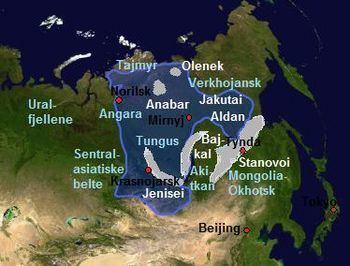 | ||
Siberia, also known as Angaraland (or simply Angara) and Angarida, is an ancient craton located in the heart of Siberia. Today forming the Central Siberian Plateau, it formed an independent continent before the Permian.
Contents
Angaraland was named in the 1880s by Austrian geologist Eduard Suess who erroneously believed that in the Paleozoic there were two large continents in the Northern Hemisphere: "Atlantis", North America connected to Europe by a peninsula (=Greenland and Iceland); and "Angara-land", eastern Asia, named after the Angara River in Siberia.
Precambrian history
About 2.5 billion years ago (Siderian), Siberia was part of a continent of Arctica, along with the Canadian Shield. Around 1.1 billion years ago (Stenian), Siberia became part of the major supercontinent of Rodinia, a state of affairs which lasted until the Cryogenian about 750 million years ago when it broke up, and Siberia became part of the minor supercontinent of Protolaurasia. During the Ediacaran Period around 600 million years ago, Protolaurasia became part of the major southern supercontinent of Pannotia but around 550 million years ago, both Pannotia and Protolaurasia split up to become the continents of Laurentia, Baltica and Siberia.
Paleozoic history
Siberia was an independent continent through the lower Paleozoic until, during the Carboniferous Period, it collided with the minor continent of Kazakhstania. A subsequent collision with Baltica during the Permian completed the formation of the supercontinent Pangaea. The Siberian Traps formed.
Mesozoic and Cenozoic history
Pangaea split up during the Jurassic though Siberia stayed with Laurasia. Laurasia gradually split up during the Cretaceous with Siberia remaining part of present-day northeastern Eurasia. Today, Siberia forms part of the minor supercontinent of Afro-Eurasia. In around 250 million years from now Siberia may be in the subtropical region and part of a new supercontinent of Pangaea Ultima.
